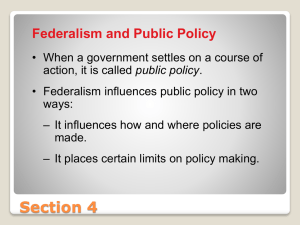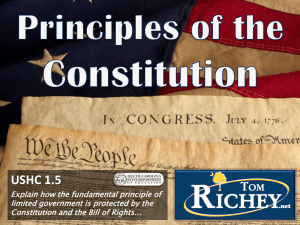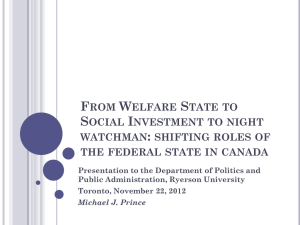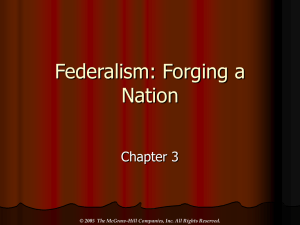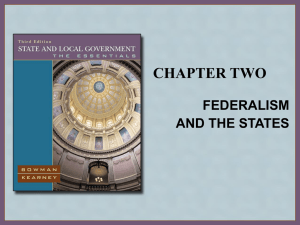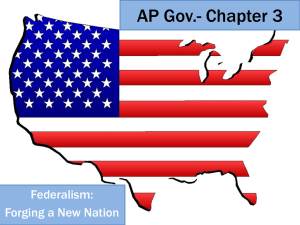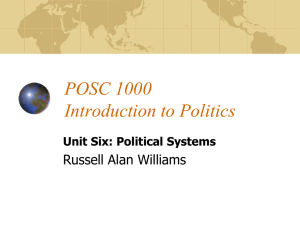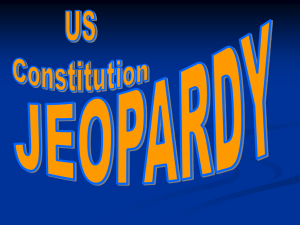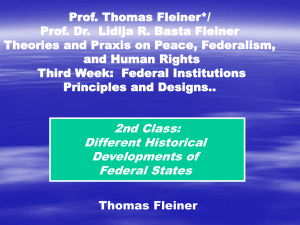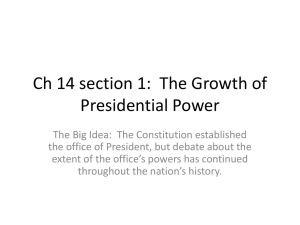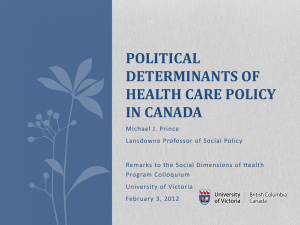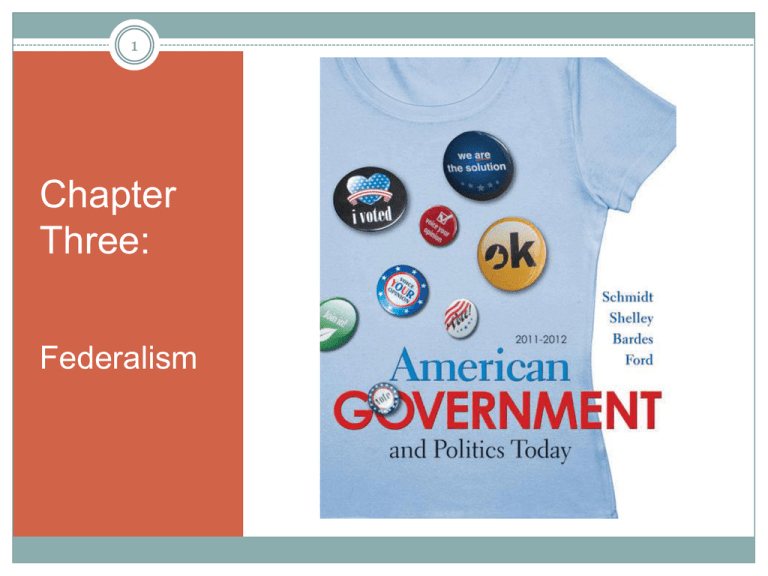
1
Chapter
Three:
Federalism
Learning Objectives
2
Define three ways nations structure relations
between a central government and local units
of government (unitary, confederal, federal).
Describe the historical arguments for and
against federalism in the United States.
Identify and explain the division of powers
between the national and state governments in
the American federal system.
Learning Objectives
3
Identify and distinguish between expressed,
implied, and inherent national powers.
Identify and distinguish the reserved from
implied powers of the state.
Define concurrent powers and explain with
examples.
Identify the limits on power contained in the
Constitution.
Learning Objectives
4
Explain the Supremacy Clause and its
implications.
Explain the obligations states have to each
other.
Use the Court’s holdings in McCulloch v.
Maryland and Gibbons v. Ogden to explain the
evolution of boundaries between federal and
state power.
Explain the importance of the Commerce
Clause in expanding federal powers.
Learning Objectives
5
Explain the impact of the Civil War on
federalism.
Explain the rights granted by the Civil War
amendments, and their impact on federalism.
Describe dual federalism as it evolved after the
Civil War.
Explain how dual federalism was replaced by
cooperative federalism and how the Supreme
Court’s resistance to cooperative federalism
came to an end.
Learning Objectives
6
Explain the tools of cooperative federalism,
including categorical grants and block grants.
Describe the impact of federal mandates on
state and local governments.
Explain why conservatism has been associated
with states’ rights and how the national
government has been a force for change.
Assess recent trends in Supreme Court rulings
affecting federalism.
Three Systems of Government
7
Unitary System
Confederal System
Federal System
Three Systems of Government
8
Why Federalism?
9
System retained state traditions and local
power while establishing a strong national
government capable of handling common
problems.
Geography made it difficult to locate political
authority in one place.
System allowed people more access to
government and influence on policies.
Why Federalism?
10
Benefits of Federalism
Helps
train future national leaders.
Provides
testing grounds for new government
initiatives.
Allows
for diverse political cultures.
Why Federalism?
11
Why Federalism?
12
Why Federalism?
13
Arguments Against Federalism
States
and local interests can impede national
government plans.
Smaller
governmental units can be dominated by a
single political group.
Can
result in inequalities among the states
The Constitutional Basis for American
Federalism
14
Powers given to the national government
Powers given to state governments
Powers prohibited to both national and state
governments
The Constitutional Basis for American
Federalism
15
Powers of the National Government
Enumerated
Implied
Powers
Powers—The Necessary and Proper
Clause
Inherent
Powers
The Constitutional Basis for American
Federalism
16
Powers of the State Governments
Reserved
Powers: According to the 10th
Amendment, all powers not delegated to the
national government are reserved to the states.
The
states have police power—the authority to
legislate for the protection of the health, morals,
safety, and welfare of the people.
The Constitutional Basis for American
Federalism
17
Concurrent Power—These powers are shared by
both the national and state governments:
Power to tax
Power to borrow money
Power to establish courts
Power to charter banks and create corporations
Power to make and enforce laws
The Constitutional Basis for American
Federalism
18
Prohibited Powers—The Constitution prohibits
the national government:
the power to impose taxes on goods sold to
other countries (exports).
any power not granted expressly or implicitly to
the federal government by the Constitution.
The Constitutional Basis for American
Federalism
19
Prohibited Powers (Continued)
States are also denied certain powers:
to enter into a treaty on its own with another
country.
to coin money.
The Constitutional Basis for American
Federalism
20
Supremacy Clause
Article
VI of the Constitution mandates that
actions by the national government are supreme.
Any
conflict between a legitimate action of the
national government and a state will be resolved
in favor of the national government.
The Constitutional Basis for American
Federalism
21
Vertical Checks and Balances
The federal system itself is a check on both
national and state power. For example:
Reserved power of the states checks the national
government.
National government can influence the states
through federal grants.
The Constitutional Basis for American
Federalism
22
Interstate Relations
Each
state is equal to another.
Article IV of the Constitution attempts to resolve
potential problems between states by stipulating
the following:
Full
faith and credit clause—states must honor actions
of other states
Privileges and immunities
Interstate extradition
Interstate compacts
Defining Constitutional
Powers—The Early Years
23
McCulloch v. Maryland (1819)
Gibbons v. Ogden (1824)
States’ Rights and the Resort to Civil War
24
The North and South became sharply divided
over the issues of tariffs and slavery.
On December 20, 1860 South Carolina
repealed its ratification of the Constitution and
withdrew from the Union.
On February 4, 1861 six states withdrew and
formed the Confederate States of America.
States’ Rights and the Resort to Civil War
25
States’ Rights and the Resort to Civil War
26
The Civil War Amendments
Thirteenth
Amendment (1865): abolished slavery.
Fourteenth Amendment (1868): “[no] state [shall]
deprive any person of life, liberty, or property,
without due process of law; nor deny to any
person within its jurisdiction the equal protection
of the laws.”
Fifteenth Amendment (1870): gave African
Americans the right to vote.
The Continuing Dispute over the Division of
Power
27
•
Dual Federalism
During the decades following
the Civil War, the prevailing
model was what political
scientists have called dual
federalism—a doctrine that
emphasizes a distinction
between federal and state
spheres of government
authority.
The Continuing Dispute over the Division of
Power
28
•
Cooperative Federalism
Franklin Roosevelt’s New
Deal policies led to the
end of Dual Federalism
and led to an era of
cooperative federalism in
order to address the vast
problems caused by the
Great Depression.
The Continuing Dispute over the Division of
Power
29
Methods of Implementing Cooperative
Federalism
Categorical
Block
Grants
Grants
Federal
Mandates
The Continuing Dispute over the Division of
Power
30
The Politics of Federalism
31
The national government
has been a force of social
change, such as in the
War on Poverty programs.
States tend to support the
status quo as they protect
their own power and
interests.
The Politics of Federalism
32
Federalism as a Partisan Issue
Republican
Party tends to support devolution,
the transfer of power from national to state
governments.
Today
it is not clear it is as partisan an issue, as
President Clinton signed the Welfare Reform Act
in 1996.
What If…One State’s Same-Sex Marriages Had to Be
Recognized Nationwide?
33
Traditionally, all matters involving marriage,
divorce, and the custody of children have been
handled through state laws.
A few states have passed legislation that allows
gay marriage or legally recognized civil unions.
In 1996, Congress passed the Defense of
Marriage Act, which allows state governments
to ignore same-sex marriages performed in
other states.
What If…One State’s Same-Sex Marriages Had to Be
Recognized Nationwide?
34
If the Supreme Court ruled the Defense of
Marriage Act unconstitutional, it would:
Force all states to recognize same-sex
marriages.
State inheritance laws, insurance laws, and
adoption laws would need to be changed to
accommodate same sex couples.
You Can Make a Difference:
The Department of Homeland Security and You
35
The Department of Homeland Security,
established in 2002, attempts to protect our
nation against terrorist attacks through 22
unified governmental agencies and 180,000
employees.
Questions have arisen about how money is
spent by this department as Congress grants
monies and the states administer them.
You Can Make a Difference:
The Department of Homeland Security and You
36
To research your state’s 2009 DHS grant
awards and total funding history, go to
www.dhs.gov/xgovt/grants.
Through the Citizens Corps Program, students
can get involved in a number of efforts,
including emergency preparedness, flood
preparedness, and citizen watch groups. You
can find information about local opportunities at
http://www.citizencorps.gov.

